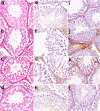Involvement of hypoxia-inducible factor1-alpha in the protective effect of rivaroxaban against testicular ischemia-reperfusion in rats
- PMID: 40730830
- PMCID: PMC12307867
- DOI: 10.1038/s41598-025-10395-2
Involvement of hypoxia-inducible factor1-alpha in the protective effect of rivaroxaban against testicular ischemia-reperfusion in rats
Abstract
This study investigated the protective effects of Rivaroxaban (RVX) against testicular ischemia-reperfusion (IR) injury in rats with a secondary aim of studying the involvement of hypoxia-inducible factor1-alpha testicular protection against ischemic insults. Twenty-four male rats were divided into four groups: sham control, testicular IR, and two RVX treatment groups (7 and 14 mg/kg) administered for one week prior to IR. Testicular IR led to significant impairment in testicular function, evidenced by an 86.5% reduction in testosterone levels and marked oxidative stress with an 189.3% increase in malondialdehyde (MDA). IR injury also triggered substantial elevations in apoptotic markers (271% increase in Bax (Bcl2-associated X protein) and 65.9% decrease in BCL2 (B-cell lymphoma 2), and inflammatory mediators (285.7% increase in NFκB (nuclear factor-kappa B). Additionally, angiogenic markers showed dramatic increases, with VEGF (vascular endothelial growth factor) and HIF-1 (Hypoxia inducible factor-1) rising by 431.8% and 519%, respectively. RVX treatment demonstrated dose-dependent protective effects, with the 14 mg/kg dose showing superior outcomes compared to 7 mg/kg. The higher dose significantly improved hormonal function (486.8% increase in testosterone), reduced oxidative stress (51.8% reduction in MDA), modulated apoptotic markers (68.3% decrease in BAX, 159.1% increase in BCL2), and normalized angiogenic factors (71.8% reduction in HIF-1). In conclusion, RVX demonstrated significant therapeutic potential in protecting against testicular IR injury, with the 14 mg/kg dose showing optimal protective effects. Reduction in HIF-1α and VEGF protein expression mediated RVX's anti-oxidant, anti-inflammatory, and anti-apoptotic effect in rats subjected to testicular IR.
Keywords: Apoptosis; HIF-1α, VEGF, oxidative stress; Rivaroxaban; Testicular ischemia-reperfusion.
© 2025. The Author(s).
Conflict of interest statement
Declarations. Competing interests: The authors declare no competing interests.
Figures







Similar articles
-
Ceratonia siliqua Protects Testicular Tissue in Ischemia/Reperfusion Injury.Int J Urol. 2025 Jul;32(7):890-899. doi: 10.1111/iju.70059. Epub 2025 Apr 1. Int J Urol. 2025. PMID: 40170082
-
[Effect of electroacupuncture on expression in blood-brain barrier in rats with cerebral ischemia-reperfusion injury by regulating HIF-1α/VEGF/MMP-9 signaling pathway].Zhen Ci Yan Jiu. 2025 Jun 25;50(6):613-623. doi: 10.13702/j.1000-0607.20241047. Zhen Ci Yan Jiu. 2025. PMID: 40551643 Chinese.
-
Role of sacubitril/valsartan in testicular ischaemia reperfusion injury via modulation of AngII/ASK/NF-κB and JAK/STAT pathways in juvenile rats.Br J Pharmacol. 2025 Sep;182(18):4343-4362. doi: 10.1111/bph.70092. Epub 2025 Jun 2. Br J Pharmacol. 2025. PMID: 40456625
-
Contribution and Regulation of HIF-1α in Testicular Injury Induced by Diabetes Mellitus.Biomolecules. 2025 Aug 19;15(8):1190. doi: 10.3390/biom15081190. Biomolecules. 2025. PMID: 40867634 Free PMC article. Review.
-
Hypoxia-inducible factor 1alpha and vascular endothelial growth factor in Glioblastoma Multiforme: a systematic review going beyond pathologic implications.Oncol Res. 2024 Jul 17;32(8):1239-1256. doi: 10.32604/or.2024.052130. eCollection 2024. Oncol Res. 2024. PMID: 39055895 Free PMC article.
References
-
- Tullington, J. E. & Blecker, N. Lower Genitourinary Trauma, in StatPearls (Treasure Island (FL), 2024). - PubMed
-
- Obi, A.O., Okeke, C.J. & Ugwuidu, E.I. Acute testicular torsion: A critical analysis of presentation, management and outcome in Southeast Nigeria. Niger J. Clin. Pract.23 (11), 1536–1541. 10.4103/njcp.njcp_188_20 (2020). - PubMed
-
- Schick, M. A. & Sternard, B. T. Testicular Torsion, in StatPearls (Treasure Island (FL), 2024). - PubMed
MeSH terms
Substances
LinkOut - more resources
Full Text Sources
Research Materials

